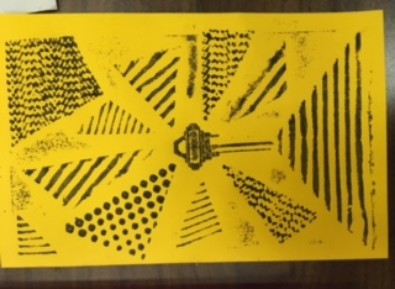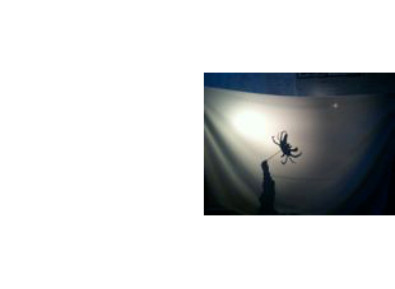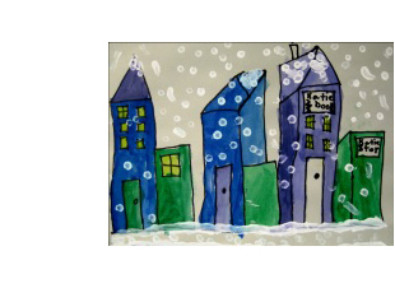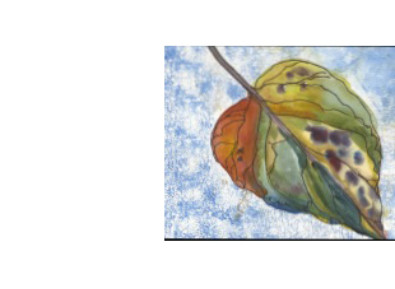Second Grade Art Kits - Descriptions
2 months ago
Bull Kelp Collage
Bull Kelp Collage
Students are inspired by a Tlingit legend, and learn about a local seaweed scientist and artist. After learning about the characteristics of bull kelp, students draw bull kelp from observation on translucent paper. Colored tissue paper is added with glue and water. Finished artwork can be hung in the window.

Butterflies and Bugs
Butterflies and Bugs
Students look at butterflies and bugs in nature to learn about symmetry. They make a symmetrical butterfly or bug.

Clan House Visit
Clan House Visit
Students work together to create a crayon resist replica of Preston Singletary’s glass house screen which can be displayed in a classroom window. They learn the basics of “Formline design,” the primary design format of the Northwest Coast Native cultures. A mini clan house model provides the class with knowledge about traditional clan houses in preparation for a visit to the Walter Soboleff Building in Juneau.

Drawing from Observation: Butterflies
Drawing from Observation: Butterflies
Student artists/scientists observe and draw real butterflies. Kit includes 30 butterfly specimens. They draw the lines, shapes, patterns, color and symmetry of these amazing creatures, and record questions about butterflies.

Drawing from Observation: Flowers
Drawing from Observation: Flowers
Using a real flower to draw from, students explore how shape, color and lines are part of the flowers "language" to attract necessary pollinators.

Drawing from Observation: Seed Pods
Drawing from Observation: Seed Pods
Students observe seed pods to examine types of seed pod structure, looking for how and where seeds are stored.

Keys to Printmaking
Keys to Printmaking
Students create a “printing plate” using materials with texture. In this experience they consider shapes and make choices about design. Session 2 is a printing workshop! Students print their design on folded paper creating a set of cards. They notice where the “focal point” of their artwork is and use their imagination to interpret their abstract designs.

Mirror Drawing with Heather Hansen
Mirror Drawing with Heather Hansen
Students watch a video of performance-artist, Heather Hansen. They work in partners to create a drawing, mirroring each others movement and marks wtih colored chalk. This lesson creates a calm and supportive environment.

Oral Stories and Alaskan Animals
Oral Stories and Alaskan Animals
Session 1: After sharing a story behind one of Aleut artist, Alvin Amason's artworks, students create art in his style. They choose an Alaskan animal from a personal story and use a "resist" technique with oil pastels and tempera paints.

Our Wild Foods
Our Wild Foods
Students are inspired by the story “Mary’s Wild Winter Feast” to make a connection with wild foods in Southeast Alaska. They create an art piece that, like the illustrations in the story, reflect both realistic depictions of wild foods, and Northwest Coast Native form line design.

Painted Mural with a Chop
Painted Mural with a Chop
Students are introduced to abstract art. They apply masking tape to a large white paper, then paint a cooperative mural in groups of 4 or 3, then add texture. They remove the tape to create contrast, then each make a personal“ signature chop” or stamp to complete the mural.

Palm Pots
Partner STEAM lesson with River Rocks science kit. Students learn how to create a simple small vessel from clay, in the palm of their hand. Clay is made of the tiniest particles of rocks and other natural matter. The pots are decorated with sand and glaze and glass, all made from sand. Firing in a kiln is required.
Palm Pots
Partner STEAM lesson with River Rocks science kit. Students learn how to create a simple small vessel from clay, in the palm of their hand. Clay is made of the tiniest particles of rocks and other natural matter. The pots are decorated with sand and glaze and glass, all made from sand. Firing in a kiln is required.

Paper Molas
Paper Molas
Students are introduced to Molas, the art made by the Kuna Indians from Panama. Students compare Tlingit Regalia and Kuna Molas. They make a layered paper mola using Alaskan animals. Students incorporate line, color, shape, and pattern in their art.

Pictographs
Pictographs
Students use information about actual pictographs found here in Alaska to do drawings on sandpaper with watercolor crayons. Oil pastels are used to recreate the surrounding area around the pictograph.

Shadow Puppets
Shadow Puppets
Students are inspired by an instructional video of Juneau performing artist, Ryan Conarro. Students choose a character from a Filipino folktale "Why Mosquitos Buzz Around our Ears," follow instructions for making a shadow puppet, and participate in a brief performance with a sheet and light (provided.) This lesson prepares students for further creation and use of shadow puppets.

Snow Village
Snow Village
Students are inspired Uri Shulevitz’s Caldecott award winning illustrations from his book titled, Snow. Students draw geometric shapes with a black marker to create a village, then choose a color scheme, and paint the village with water color paints. Finally, tempera paint is applied with a cotton swab to portray a “snow village.”

Story in a Bag (Drama kit)
Story in a Bag (Drama kit)
This drama lesson explores collaborative storytelling through improvisation. By following a Story Spine to teach basic story structure, students are guided by the teacher/narrator in creative dramatic play to invent character and plot within a setting.
Story Line
Story Line
Students identify different kinds of lines in famous artworks. They create a continuous line abstract drawing. They embellish the drawing with colored markers. Students name their embellished line art and write about their “Story Line.”

Tidal Zones Mural
Tidal Zones Mural
Students use photos of beach creatures and plants, in each of four local southest "tidal zones" to create a mural. Background texture is added with rubbing plates and creatures are drawn with oil pastels.

Watercolor Leaves
Watercolor Leaves
Students practice watercolor techniques and color mixing using primary colors and creating a color wheel. Students draw a leaf from observation, and paint it implementing new skills.
